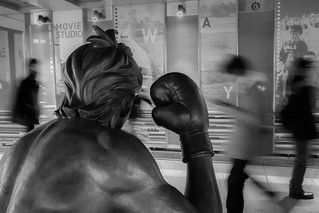I suppose even with the nowadays high ISO capabilities of the of new cameras, the tripod is still one of the most useful tools for a photographer.
It makes possible and very easy to take such photos:
(well, it is not entirely impossible to do such photos without one, but difficult at least)
To attach the camera to a tripod, a photographer uses one of the quick release systems. Unfortunately, using tripod with Fuji cameras, like T1 is not very convenient.
Mirrorless cameras require often battery changes. The tripod mount is to close to the battery compartment. The quick release plate blocks the battery change. On the other hand, I usually change the battery at least once a day, during shooting, and in the cold weather of winter - even twice. This somehow defeats the purpose of the quick release plate, if it had to be attached and detached several times a day.
On top of it, the tripod mount is not in the optical center of the camera, which makes certain tricks impossible.
Fuji offers for a fee solution to those problems: the grips. Thanks to a grip, it is possible to attach the quick release plate and still be able to change the batteries. It also has the tripod mount in the optical center of the camera.
Actually, for the T1 there are three choices. Quite expensive i must say: the large grip, a thing without any electronics, cost over $150 on Amazon.jp.
Even so, I have decided such grip to be my next buy.
It makes possible and very easy to take such photos:
(well, it is not entirely impossible to do such photos without one, but difficult at least)
To attach the camera to a tripod, a photographer uses one of the quick release systems. Unfortunately, using tripod with Fuji cameras, like T1 is not very convenient.
Mirrorless cameras require often battery changes. The tripod mount is to close to the battery compartment. The quick release plate blocks the battery change. On the other hand, I usually change the battery at least once a day, during shooting, and in the cold weather of winter - even twice. This somehow defeats the purpose of the quick release plate, if it had to be attached and detached several times a day.
On top of it, the tripod mount is not in the optical center of the camera, which makes certain tricks impossible.
Fuji offers for a fee solution to those problems: the grips. Thanks to a grip, it is possible to attach the quick release plate and still be able to change the batteries. It also has the tripod mount in the optical center of the camera.
Actually, for the T1 there are three choices. Quite expensive i must say: the large grip, a thing without any electronics, cost over $150 on Amazon.jp.
Even so, I have decided such grip to be my next buy.
